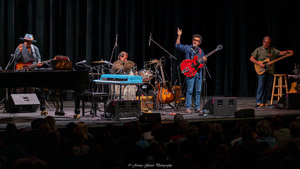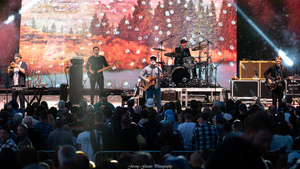Battleground
Florida and the 2004 Elections
by Shelton Hull
By most accounts, the 2000 Presidential race was decided by a hand-count of ballots filed in the state of Florida. It is not surprising that those results have been the subject of controversy ever since, nor that the events of 2000 should weigh very heavily on the action this year–a year in which the stakes are significantly higher than four years ago.
The national media has been slow to grasp the full and exact role of Florida in both the electoral and national-security scene, of which 2000 was only a part. The nuts and bolts of that “fiasco” were widely replicated in elections across the country, then and now, with hardly the hype afforded the Sunshine State. Both the Democratic and Republican parties are preparing themselves for any number of possible scenarios in which the “fiasco” of 2000 could be repeated, and again the nation’s eyes turn south.
The controversy itself centers on two interweaving lines of theory and argument: disenfranchisement of voters and miscounting of ballots. The old punch-cards sometimes left “chads,” bits of paper that didn’t break off cleanly from the hole. These chads often confused the machines programmed to read the holes, necessitating a manual count. The results of these counts, as well system of ratifying the results, is what sent the election to the US Supreme Court, after Florida Secretary of State Katherine Harris ordered a stop to hand-counting in accordance with state law. The Supremes essentially ruled that state law trumped the national interest in making sure all ballots were counted, and George W. Bush was declared the 43rd President-Elect of the United States.
Clyde Collins, Chairman of the Duval County Democratic Party, blames the problems in 2000 on overvotes–27,000 disqualified ballots in Duval alone. “Since the development of this punch-card system, the local party had complained, without a whole lot of tenor, that it was a bad system,” he says, “but certainly the Supervisor’s office never advised us that this particular punch-card system had been outlawed in several states, because it had an approximately 7% inaccuracy rate. If you look at the other elections in Duval County over the last ten years, there are a number of races in which the Party would’ve asked for a recount, had we known about the 7% error rate.” Duval will be using optical readers this year. His Republican counterpart was unavailable; Supervisor of Elections John Stafford is seriously ill, but we’ll avoid speculating about how a possible leadership vacuum will affect the SoE’s handling of the election.
Only later, after it was too late, did Democrats make noise about what many have called the deliberate suppression of votes, most of whom were black, by various means including falsified felon lists, mis-processing of registration papers and basic physical intimidation, even though this number is much, much higher than the number of shady ballots. By this point it was the chads, and the Floridians who made them, that were blamed for Bush being President; steps were taken to shore up the process and reduce the risk of human error in either voting or tabulation.
They have two main options: the “optical reader” or the “touch-screen.” Each machine is designed to minimize human error by having computers actually record the vote as it is made. The former involves marking a ballot with permanent marker, which is then run through a machine that collects the ballot while recording the votes cast. The latter involves voters making choices on a screen that records each vote in real-time; voters verify choices and submit them. Palm Beach County was a hotspot in 2000, after a number of Jewish voters were shocked to see their Gore votes attributed to the allegedly anti-Semitic Patrick J. Buchanan. PBC has been using Sequoia “Edge 1” touch-screen machines since 2002, and Tony Enos of the SoE is satisfied with their performance. “Punch-card is probably an easier system to put together, whereas any touch-screen requires more programming. The machine is programmed and ready to go, basically, when it leaves our facility, whereas the other types have to be programmed by the poll worker at the polling place that day.” Voting data is stored on a cartridge that is later removed and taken to the Supervisor’s office for tabulation.
While the machines are generally regarded as infallible by officials, each method leaves room for both human and computer “error.” Touch-screen machines won’t allow overvotes, but it will allow undervotes, which are sometimes made in protest and can be ratified on-screen. Also, each unit has up to 12 hours of back-up power, in case of an outage or, worse, a full-on attack on the state’s power grid.
“The elections have gone smoothly,” says Seth Kaplan, Executive Assistant for Public Affairs at the SoE of Miami-Dade County, which has been using the infamous Diebold touch-screen machines in all of its 749 precincts (serving just under one million registered voters) since 2002. The results were very tight down there, as Joe Lieberman made the Democrats unusually attractive to large, typically Republican segments of that community. “There was a mandate to very quickly switch systems. The first election [Sept. 2002] was tough; in November the election went well, but with an extraordinary deployment of resources. It was a very expensive election. We had three county employees at every polling place, in addition to the usual clerks and so forth, so that wasn’t sustainable.”
Mis-marking of ballots is the obvious concern, but the possibility of sabotaging the machines remains sketchy and divisive. The units are not networked to each other; thus all but impervious to external manipulation. However, it may still be possible to penetrate the system at the point (usually an SoE office) where totals are tallied at the local or state level. Security will be increased at polling places, augmented by oversight from the major parties in areas where problems occurred in 2000, so it’s not expected that anyone will be able to steal machines or cartridges in transit.
Miami-Dade was the scene of social unrest after 2000, so of course they have taken the lead in revising electoral infrastructure for 2004. They have printed several hundred thousand back-up ballots (in a county with over 900,000 registered voters), just in case of what Kaplan calls “a more catastrophic failure” of the machines. The police will be on high alert from one end of the state to the other, and the National Guard will be ready, though it is unthinkable that they would be necessary.
In this reporter’s opinion, the only way to effect large-scale vote-tampering this year would be to do so from inside–and that is the one scenario that no one will speak about on the record. Off-record, however, a number of election officials, journalists and political figures in the state (none of whom are quoted in this article) concede that anything is possible. The mentality that would lead to such activity is by nature more compelling that any passion to preserve the integrity of the process, especially if the system is accepted as tamper-proof. As one source put it, “All of this has happened before, and it could happen again, unfortunately.” ◼












